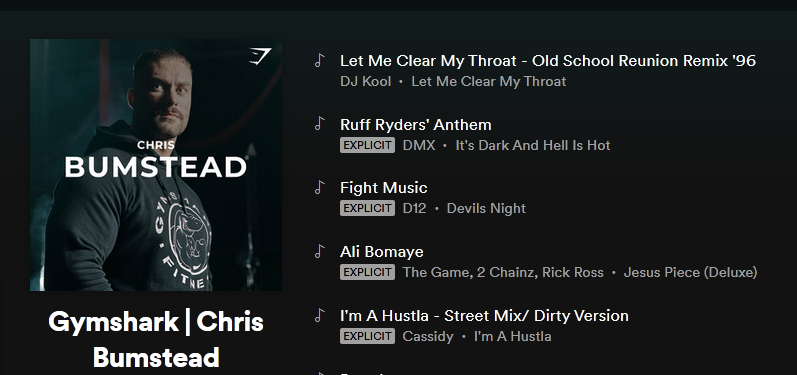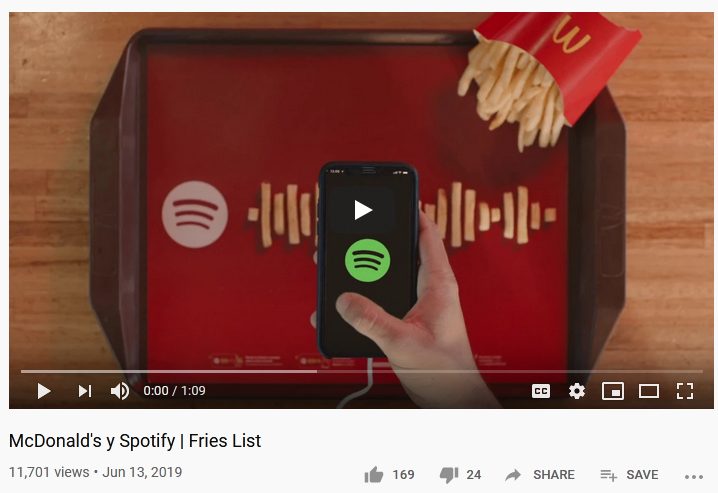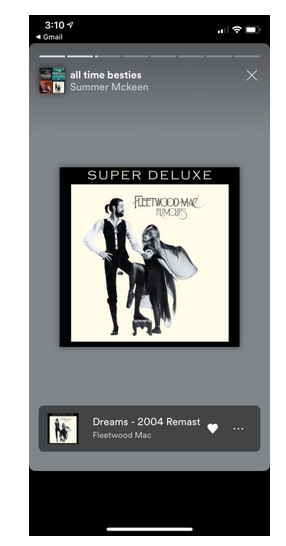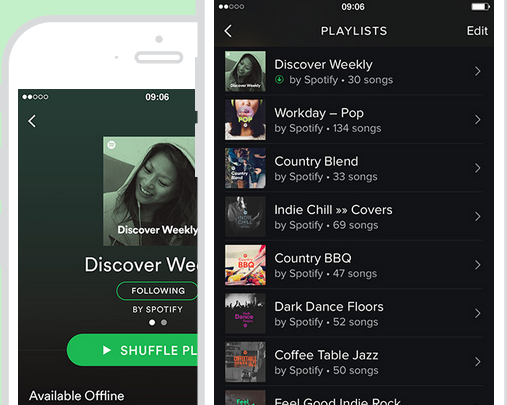When we talk about influencer marketing, what platforms come to your mind? Instagram, Facebook, YouTube, maybe LinkedIn or even Twitter. Did you even think of Spotify? No, right? Well, you should. Brands and consumers are flocking to Spotify and influencers should follow suit.
Spotify is grabbing the limelight for a number of reasons:
- Spotify is the world’s largest audio platform with 217 monthly active users (MAU).
- Users are spending 25 hours a month listening to music on Spotify and 44% of users visit Spotify daily.
- Spotify’s monthly active user (MAU) base grew by almost 26% YoY in Q1 of 2019.
- User-generated playlists attribute to one-third of the total listening time on Spotify. This means you can get great organic reach for virtually no cost.

With numbers like these, it’s clear that consumers are loving Spotify. Since influencers and marketers need to be where their audiences are, Spotify is the place to be.
Influencer Marketing on Spotify:
Is Spotify the Right Platform for You?
As a smart marketer, you need to take a deeper look at Spotify’s user composition to understand if your target market overlaps with the user base of Spotify. Only then, it makes sense to jump onto the Spotify marketing bandwagon.
Research has revealed the following facts about Spotify users:
- Region demographics: Spotify users and subscribers are mostly from Europe (36%), followed by North America (29%), Latin America (22%), and then the rest of the world (13%).
- Age demographics: 39% of music listeners below 30 years of age consider Spotify as their favourite channel, making Spotify the top choice of millennial music lovers. Further age breakdown of Spotify users shows that the platform is most popular among these age groups (in decreasing order): 25-34 years, 18-25 years, and 55-60 years.
- Gender demographics: A Statista survey shows that 23% of males and 20% female in the US are Spotify users.
If your audience falls into the above-mentioned groups, you need to be more active on Spotify. But that isn’t all.
What’s more, you ask? Your content and industry need to match too.
Spotify’s content is dominated by music and podcasts. If your audiences are avid music lovers, Spotify is your ideal match. If your existing and prospective clients are either from the music or the over the top (OTT) media industry, Spotify is tailor-made for you. But this doesn’t mean that other influencers can’t capitalise on Spotify’s popularity.
If you or your brand partners deal with a lot of user-generated content, you have a chance to score on Spotify as user-generated playlists are extremely popular on Spotify, as stated earlier. So, how exactly can you start with influencer marketing on Spotify?
How Can You Do Influencer Marketing on Spotify?
Are you ready to turbocharge your influencer campaigns through Spotify?
To connect with users organically, you have two options:
- Playlists
- Podcasts
Let’s discuss them one by one, with examples.
Playlists
Playlists are the main attraction on Spotify. It has almost two billion playlists. What are your chances of standing out in that ocean of content? To get the answer, you need to understand some basic facts about Spotify playlists.
There are two types of playlists on Spotify:
- Spotify-curated playlists: These are recommended by Spotify through its AI-powered algorithm. Brands can also sponsor some of Spotify’s flagship lists.
- User-generated playlists: These are created by users or subscribers.
Although you can’t exactly crack Spotify’s algorithm, you can hope to score in the user-generated department. There are added advantages of leveraging user-generated content like the freedom to experiment, negligible production costs, and ease of setting up.
Gymshark, a fitness apparel brand, gets influencers to create branded playlists for promotion. Since workouts and music go hand in hand, promoting on Spotify makes sense for Gymshark. Their team of ambassadors and influencers are fitness models like Mr.Olympia, Christopher Bumstead. They use their personal favourites to build audio playlists.

Image via Spotify
Gymshark pitches the playlists via Twitter to their consumers, who are mainly fitness freaks. Partner influencers also spread the word via other social channels like Instagram.
Mission complete.
Chris Bumstead is the new Classic #Olympia champion! ??? pic.twitter.com/ulOXKB5ail
— Gymshark (@Gymshark) September 15, 2019
Now, let me guess. You’re thinking you and your clients have nothing to do with music or bands. So, can you make it big on Spotify?
Want to know the good news? It’s not only music-inclined brands that are using Spotify playlists to engage audiences. Spotify is becoming a favourite of people from all walks of life. For instance, fast food brands like McDonald’s and Coca-Cola are thinking of innovative ways to appeal to music-loving foodies.
McDonald's wanted to liven up customers' in-restaurant experience in Latin America using Spotify. They launched a campaign that turns its french fries into a Spotify playlist. They challenged customers to fit their fries on outlines that are printed on their tray liners. Enter Spotify. Customers are told to scan the code on their tray liner to call up a playlist titled "FriesList" containing themed tracks, such as "FriTops of the Moment" and “I'm Out of Fries." While McDonald’s didn’t hire influencers to do the job for them, they came across as a fun brand.

Video URL
As artists make money out of Spotify playlists, adding them to playlists on your client’s brand page can result in infringement issues. Unlike Instagram, there is no option of declaring “sponsored” posts or reposting on Spotify.
To avoid disputes, Spotify has prescribed some best practices:
- Try to include 20 or more tracks in your playlists so that there is no implication of endorsement contracts with a particular artist.
- Don’t add more than one track by a single artist.
- Avoid tracks by artists who are collaborating with competitor brands or have publicly expressed aversion to values, products, or services that your brand is providing.
- Don’t treat your playlists as commercials. They should portray your brand’s personality and vibe, rather than trying to sell anything. You have the option of buying ads on Spotify.
Spotify Stories is the newest update on the platform and it’s a great opportunity for influencers to bundle content based on themes and purposes. Currently, Spotify is testing the Stories feature with select influencers, such as YouTube megastar, Summer Mckeen.
Similar to Instagram and Facebook, Spotify Stories will contain short video or audio clips that users can tap on, watch, and to move to the next. You can use album art or animation to make your Story cover photo. By including captivating content in Stories, influencers and marketers can keep followers engaged for longer.

Image via Spotify
Sponsored playlists provide another avenue to grab consumer attention. Spotify allows brands to sponsor platform-recommended playlists and personalise them for more targeted messaging.
Recently, Spotify opened up its hugely popular Discover Weekly playlist to brands. What is the Discover Weekly playlist?
Every Monday, Spotify greets its users with a Discover Weekly playlist that contains a collection of 30 tracks specially curated by Spotify’s AI engine. The Discover Weekly playlist displays on users’ pages for one week.

Image via Shopify
For influencers and brands, this week-long window is an opportunity to get more consistent engagement for their content. They also get to extract more returns for their ad spend.
The high level of personalisation is bound to delight consumers. Owing to the personalised quality of Discover Weekly, listeners are streaming twice the amount of content than users who don’t use the playlist.
Podcasts
Spotify is investing big bucks into podcasts after acquiring podcast startups like Gimlet and Anchor earlier this year. For brands and influencers, this is another avenue to connect with their audiences. With the revival of radio culture, especially in Latin America, podcasts have also risen in the popularity charts.
Unlike social platforms where users spend maximum time browsing and swiping, podcasts get undivided attention from listeners for 30, 60, or even 90 minutes. This sort of engagement is almost unheard of among digital circles.
Spotify is planning to insert targeted ads into podcasts in real-time after collating its rich customer insights. Using the Streaming Ad Insertion technology, Spotify will study a user’s tastes, location, and age to identify ads that will be received favourably by the user. So how can influencers leverage podcasts on Spotify?
Besides creating great content for podcasts, influencers need to pay special attention to distribution methods. An efficient distribution will ensure that your podcasts reach the right audiences.
You can use these battle-tested hacks to perfect your podcast distribution strategy:
- Promote your podcasts across channels: You can collaborate with cross-channel podcasts specialists such as Phoebe Robinson to get more visibility for your podcasts. Of course, you will have to spread the word through your website, blog, and social channels too. Apps like Anchor and Simplecast will upload your podcasts and publish them on Spotify, Apple Podcasts, Google Podcasts, and other hosting platforms. They also offer real-time analytics on your show’s performance.
- Optimise your podcast’s title and the headline: You can research names that are creative, unique, and contextual for your podcast episodes.
Ready to Start Your Spotify Influencer Marketing Campaign?
Nobody would have imagined that Spotify would become an influencer marketing platform, but it has. If done well, marketing on Spotify is a sure-shot way of reaching out to music-loving audiences. Using the right influencers can further widen your reach. So, what are you waiting for? There’s no better time to get started with influencer marketing on Spotify. And armed with the guide above, you’re ready to get started today.



